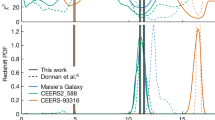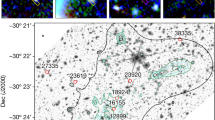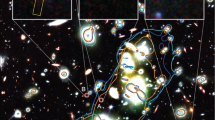Abstract
Galaxies had their most significant impact on the Universe when they assembled their first generations of stars. Energetic photons emitted by young, massive stars in primeval galaxies ionized the intergalactic medium surrounding their host galaxies, cleared sightlines along which the light of the young galaxies could escape, and fundamentally altered the physical state of the intergalactic gas in the Universe continuously until the present day1,2. Observations of the cosmic microwave background3, and of galaxies and quasars at the highest redshifts4, suggest that the Universe was reionized through a complex process that was completed about a billion years after the Big Bang, by redshift z ≈ 6. Detecting ionizing Lyman-α photons from increasingly distant galaxies places important constraints on the timing, location and nature of the sources responsible for reionization. Here we report the detection of Lyα photons emitted less than 600 million years after the Big Bang. UDFy-38135539 (ref. 5) is at a redshift of z = 8.5549 ± 0.0002, which is greater than those of the previously known most distant objects, at z = 8.2 (refs 6 and 7) and z = 6.96 (ref. 8). We find that this single source is unlikely to provide enough photons to ionize the volume necessary for the emission line to escape, requiring a significant contribution from other, probably fainter galaxies nearby9.
This is a preview of subscription content, access via your institution
Access options
Subscribe to this journal
Receive 51 print issues and online access
$199.00 per year
only $3.90 per issue
Buy this article
- Purchase on Springer Link
- Instant access to full article PDF
Prices may be subject to local taxes which are calculated during checkout



Similar content being viewed by others
References
Mesinger, A. & Furlanetto, S. Efficient simulations of early structure formation and reionization. Astrophys. J. 669, 663–675 (2007)
Choudhury, T. R., Haehnelt, M. G. & Regan, J. Inside-out or outside-in: the topology of reionization in the photon-starved regime suggested by Ly-alpha forest data. Mon. Not. R. Astron. Soc. 394, 960–977 (2009)
Komatsu, E. et al. Seven-year Wilkinson Microwave Anisotropy Probe (WMAP) observations: cosmological interpretation. Astrophys. J. Suppl. Ser. (submitted); preprint at 〈http://arxiv.org/abs/1001.4538〉 (2010)
Fan, X. et al. Constraining the evolution of the ionizing background and the epoch of reionization with z ∼ 6 quasars. II. A sample of 19 quasars. Astron. J. 132, 117–136 (2006)
Bouwens, R. J. et al. Discovery of z ∼ 8 galaxies in the Hubble Ultra Deep Field from ultra-deep WFC3/IR observations. Astrophys. J. 709, L133–L137 (2010)
Tanvir, N. R. et al. A γ-ray burst at a redshift of z ≈ 8.2. Nature 461, 1254–1257 (2009)
Salvaterra, R. et al. GRB090423 at a redshift of z ≈ 8.1. Nature 461, 1258–1260 (2009)
Iye, M. et al. A galaxy at a redshift z = 6.96. Nature 443, 186–188 (2006)
Loeb, A., Barkana, R. & Hernquist, L. Was the universe reionized at redshift 10? Astrophys. J. 620, 553–558 (2005)
McLure, R. J. et al. Galaxies at z = 6–9 from the WFC3/IR imaging of the Hubble Ultra Deep Field. Mon. Not. R. Astron. Soc. 403, 960–983 (2010)
Ouchi, M. et al. The Subaru/XMM-Newton Deep Survey (SXDS). IV. Evolution of Lyα emitters from z = 3.1 to 5.7 in the 1 deg2 field: luminosity functions and AGN. Astrophys. J. Suppl. Ser. 176, 301–330 (2008)
Ota, K. et al. Reionization and galaxy evolution probed by z = 7 Lyα emitters. Astrophys. J. 677, 12–26 (2008)
Ouchi, M. et al. Large Area Survey for z = 7 galaxies in SDF and GOODS-N: implications for galaxy formation and cosmic reionization. Astrophys. J. 706, 1136–1151 (2009)
Castellano, M. et al. Evidence of a fast evolution of the UV luminosity function beyond redshift 6 from a deep HAWK-I survey of the GOODS-S field. Astron. Astrophys. 511, A20–A36 (2010)
Verma, A., Lehnert, M. D., Förster Schreiber, N. M., Bremer, M. N. & Douglas, L. Lyman-break galaxies at z ∼ 5 - I. First significant stellar mass assembly in galaxies that are not simply z ∼ 3 LBGs at higher redshift. Mon. Not. R. Astron. Soc. 377, 1024–1042 (2007)
Stark, D. P. et al. The evolutionary history of Lyman break galaxies between redshift 4 and 6: observing successive generations of massive galaxies in formation. Astrophys. J. 697, 1493–1511 (2009)
Bouwens, R. J. et al. Very blue UV-continuum slope β of low luminosity z ∼ 7 galaxies from WFC3/IR: evidence for extremely low metallicities? Astrophys. J. 708, L69–L73 (2010)
Bromm, V., Kudritzki, R. P. & Loeb, A. Generic spectrum and ionization efficiency of a heavy initial mass function for the first stars. Astrophys. J. 552, 464–472 (2001)
Labbé, I. et al. Star formation rates and stellar masses of z = 7–8 galaxies from IRAC observations of the WFC3/IR Early Release Science and the HUDF fields. Astrophys. J. 716, L103–L108 (2010)
Furlanetto, S. R., Haiman, Z. & Oh, S. P. Fossil ionized bubbles around dead quasars during reionization. Astrophys. J. 686, 25–40 (2008)
Miralda-Escude, J. Reionization of the intergalactic medium and the damping wing of the Gunn-Peterson trough. Astrophys. J. 501, 15–22 (1998)
Wyithe, J. S. B. & Loeb, A. Undetected sources allow transmission of the Lyα line from galaxies prior to reionization. Astrophys. J. 625, 1–5 (2005)
Dijkstra, M. & Wyithe, S. Seeing through the trough: outflows and the detectability of Lyα emission from the first galaxies. Mon. Not. R. Astron. Soc. 10.1111/j.1365-2966.2010.17112.x (in the press)
Wyithe, J. S. B. & Loeb, A. A characteristic size of ∼10 Mpc for the ionized bubbles at the end of cosmic reionization. Nature 432, 194–196 (2004)
Miralda-Escudé, J., Haehnelt, M. & Rees, M. J. Reionization of the inhomogeneous Universe. Astrophys. J. 530, 1–16 (2000)
Scalo, J. in The Stellar Initial Mass Function (38th Herstmonceux Conference) (eds Gilmore, G. & Howell, D.) 210–209 (ASP Conf. Ser. 142, Astronomical Society of the Pacific, 1998)
Deharveng, J.-M. et al. Constraints on the Lyman continuum radiation from galaxies: first results with FUSE on Mrk 54. Astron. Astrophys. 375, 805–813 (2001)
Inoue, A. K., Iwata, I., Deharveng, J.-M., Buat, V. & Burgarella, D. VLT narrow-band photometry in the Lyman continuum of two galaxies at z ∼ 3. Limits to the escape of ionizing flux. Astron. Astrophys. 435, 471–482 (2005)
Bergvall, N. et al. First detection of Lyman continuum escape from a local starburst galaxy. I. Observations of the luminous blue compact galaxy Haro 11 with the Far Ultraviolet Spectroscopic Explorer (FUSE). Astron. Astrophys. 448, 513–524 (2006)
Acknowledgements
We thank the Director General of the ESO for generous allocation of time and the staff on Paranal for conducting the observations. We also thank F. Combes, S. Zaroubi, M. Haehnelt, D. Valls-Gabaud and J. Dunlop for discussions.
Author information
Authors and Affiliations
Contributions
M.D.L. led the writing of the paper and the presentation of the results and was responsible for the modelling shown in Fig. 3. N.P.H.N. designed the observations, reduced all of the data and was responsible for the data shown in Figs 1 and 2. A.M.S., J.-G.C., B.C. and S.B. also examined the data. S.M., M.N.B., N.P.H.N. and A.M.S. helped significantly in editing the manuscript. All authors discussed the results and commented on the manuscript.
Corresponding authors
Ethics declarations
Competing interests
The authors declare no competing financial interests.
Supplementary information
Supplementary Information
This file contains Supplementary Information comprising: Observations and data reduction; The nature of the line and Other Possible Sources of Line Emission. It also contains Supplementary Figures 1-3 with legends and additional references. (PDF 168 kb)
Rights and permissions
About this article
Cite this article
Lehnert, M., Nesvadba, N., Cuby, JG. et al. Spectroscopic confirmation of a galaxy at redshift z = 8.6. Nature 467, 940–942 (2010). https://doi.org/10.1038/nature09462
Received:
Accepted:
Published:
Issue Date:
DOI: https://doi.org/10.1038/nature09462
This article is cited by
-
Scientific Images as Circulating Ideas: An Application of Ludwik Fleck’s Theory of Thought Styles
Journal for General Philosophy of Science (2016)
-
Dark energy and fundamental physics
The Astronomy and Astrophysics Review (2013)
-
A luminous quasar at a redshift of z = 7.085
Nature (2011)
-
A candidate redshift z ≈ 10 galaxy and rapid changes in that population at an age of 500 Myr
Nature (2011)
Comments
By submitting a comment you agree to abide by our Terms and Community Guidelines. If you find something abusive or that does not comply with our terms or guidelines please flag it as inappropriate.



